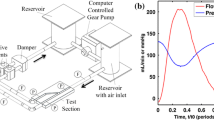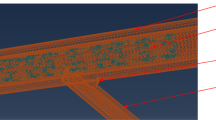Abstract
The treatment of coronary bifurcation lesions represents a challenge for the interventional cardiologists due to the lower rate of procedural success and the higher risk of restenosis. The advent of drug-eluting stents (DES) has dramatically reduced restenosis and consequently the request for re-intervention. The aim of the present work is to provide further insight about the effectiveness of DES by means of a computational study that combines virtual stent implantation, fluid dynamics and drug release for different stenting protocols currently used in the treatment of a coronary artery bifurcation. An explicit dynamic finite element model is developed in order to obtain realistic configurations of the implanted devices used to perform fluid dynamics analysis by means of a previously developed finite element method coupling the blood flow and the intramural plasma filtration in rigid arteries. To efficiently model the drug release, a multiscale strategy is adopted, ranging from lumped parameter model accounting for drug release to fully 3-D models for drug transport to the artery. Differences in drug delivery to the artery are evaluated with respect to local drug dosage. This model allowed to compare alternative stenting configurations (namely the Provisional Side Branch, the Culotte and the Inverted Culotte techniques), thus suggesting guidelines in the treatment of coronary bifurcation lesions and addressing clinical issues such as the effectiveness of drug delivery to lesions in the side branch, as well as the influence of incomplete strut apposition and overlapping stents.
Similar content being viewed by others
References
Adriaenssens T, Byrne RA, Dibra A, Iijima R, Mehilli J, Bruskina O, Schömig A, Kastrati A (2008) Culotte stenting technique in coronary bifurcation disease: Angiographic follow-up using dedicated quantitative coronary angiographic analysis and 12-month clinical outcomes. Eur Heart J 29: 2868–2876
Assali AR, Assa HV, Ben-Dor I, Teplitsky I, Solodky A, Brosh D, Fuchs S, Kornowski R (2006) Drug-eluting stents in bifurcation lesions: to stent one branch or both. Catheter Cardiovasc Interv 68: 891–896
Balakrishnan B, Dooley J, Kopia G, Edelman ER (2008) Thrombus causes fluctuations in arterial drug delivery from intravascular stents. J Controlled Release 131: 173–180
Balakrishnan B, Dooley JF, Kopia G, Edelman ER (2007) Intravascular drug release kinetics dictate arterial drug deposition, retention, and distribution. J Controlled Release 123: 100–108
Balakrishnan B, Tzafriri AR, Seifert P, Groothuis A, Rogers C, Edelman BR (2005) Strut position, blood flow, and drug deposition: Implications for single and overlapping drug-eluting stents. Circulation 111: 2958–2965
Biscari P, Minisini S, Pierotti D, Verzini G, Zunino P (2011) Controlled release with finite dissolution rate. SIAM J Appl Math 71: 731–752
Borghi A, Foa E, Balossino R, Migliavacca F, Dubini G (2008) Modelling drug elution from stents: effects of reversible binding in the vascular wall and degradable polymeric matrix. Comput Methods Biomech Biomed Eng 11: 367–377
Chevalier B, Glatt B, Royer T, Guyon P (1998) Placement of coronary stents in bifurcation lesions by the “Culotte” technique. Am J Cardiol 82: 943–949
Collet C, Costa RA, Abizaid A (2011) Dedicated bifurcation analysis: dedicated devices. Int J Cardiovasc Imaging 27: 181–188
D’Angelo C, Zunino P (2011) Robust numerical approximation of coupled Stokes’ and Darcy’s flows applied to vascular hemodynamics and biochemical transport. ESAIM Math Model Numer Anal 45: 447–476
D’Angelo C, Zunino P, Porpora A, Morlacchi S, Migliavacca F (2011) Model reduction strategies enable computational analysis of controlled drug release from cardiovascular stents. SIAM J Appl Math 71: 2312–2333
D’Angelo C, Zunino P (2012) Numerical approximation with Nitsche’s coupling of transient Stokes’/Darcy’s flow problems applied to hemodynamics. Appl Numer Math 62(4): 378–395
Formaggia L, Quarteroni A, Veneziani A (2009) Cardiovascular mathematics modeling and simulation of the circulatory system. Springer, Milano
Frenning G (2003) Theoretical investigation of drug release from planar matrix systems: effects of a finite dissolution rate. J Controlled Release 92: 331–339
Gastaldi D, Morlacchi S, Nichetti R, Capelli C, Dubini G, Petrini L, Migliavacca F (2010) Modelling of the provisional side-branch stenting approach for the treatment of atherosclerotic coronary bifurcations: effects of stent positioning. Biomech Model Mechanobiol 9: 551–561
Grassi M, Pontrelli G, Teresi L, Grassi G, Comel L, Ferluga A, Galasso L (2009) Novel design of drug delivery in stented arteries: a numerical comparative study. Math Biosci Eng 6: 493–508
Gonzalo N, Garcia-Garcia HM, Regar E, Barlis P, Wentzel J, Onuma Y, Ligthart J, Serruys PW (2009) In vivo assessment of high-risk coronary plaques at bifurcations with combined intravascular ultrasound and optical coherence tomography. JACC Cardiovasc Imaging 2: 473–482
Higuchi T (1961) Rate of release of medicaments from ointment bases containing drugs in suspension. J Pharm Sci 50: 874–875
Holzapfel GA, Sommer G, Gasser CT, Regitnig P (2005) Determination of layer-specific mechanical properties of human coronary arteries with nonatherosclerotic intimal thickening and related constitutive modeling. Am J Physiol Heart Circ Physiol 289: H2048–H2058
Hose DR, Narracott AJ, Griffiths B, Mahmood S, Gunn J, Sweeney D, Lawford PV (2004) A thermal analogy for modelling drug elution from cardiovascular stents. Comput Methods Biomech Biomed Eng 7: 257–264
Hossain SS, Hossainy SFA, Bazilevs Y, Calo VM, Hughes TJR (2012) Mathematical modeling of coupled drug and drug-encapsulated nanoparticle transport in patient-specific coronary artery walls. Comput Mech 49: 213–242
Hoye A (2006) Contemporary percutaneous coronary intervention for complex lesions: the treatment of chronic total occlusions and bifurcations in the drug-eluting stent era. Ph.D. thesis. http://repub.eur.nl/res/pub/7642/
Hwang C-, Wu D, Edelman ER (2001) Physiological transport forces govern drug distribution for stent-based delivery. Circulation 104: 600–605
Iakovou I, Ge L, Colombo A (2005) Contemporary stent treatment of coronary bifurcations. J Am Coll Cardiol 46: 1446–1455
Kolachalama VB, Levine EG, Edelman ER (2009a) Luminal flow amplifies stent-based drug deposition in arterial bifurcations. PLoS ONE 4
Kolachalama VB, Tzafriri AR, Arifin DY, Edelman ER (2009b) Luminal flow patterns dictate arterial drug deposition in stent-based delivery. J Controlled Release 133: 24–30
Lanzer P, Gijsen FJH, Topoleski LDT, Holzapfel GA (2010) Call for standards in technical documentation of intracoronary stents. Herz 35: 27–33
Lefèvre T, Louvard Y, Morice M, Dumas P, Loubeyre C, Benslimane A, Premchand RK, Guillard N, Piéchaud J (2000) Stenting of bifurcation lesions: classification, treatments, and results. Catheter Cardiovasc Interv 49: 274–283
Lovich MA, Edelman ER (1996) Computational simulations of local vascular heparin deposition and distribution. Am J Physiol Heart Circ Physiol 271: H2014–H2024
Migliavacca F, Gervaso F, Prosi M, Zunino P, Minisini S, Formaggia L, Dubini G (2007) Expansion and drug elution model of a coronary stent. Comput Methods Biomech Biomed Eng 10: 63–73
Mongrain R, Faik I, Leask RL, Rodés-Cabau J, Bertrand OF, Bertrand OF (2007) Effects of diffusion coefficients and struts apposition using numerical simulations for drug eluting coronary stents. J Biomech Eng 129: 733–742
Morice M-, Serruys PW, Eduardo Sousa J, Fajadet J, Hayashi EB, Perin M, Colombo A, Schuler G, Barragan P, Guagliumi G, Molnà àr F, Falotico R (2002) A randomized comparison of a sirolimus-eluting stent with a standard stent for coronary revascularization. N Engl J Med 346: 1773–1780
Morlacchi S, Chiastra C, Gastaldi D, Pennati G, Dubini G, Migliavacca F (2011) Sequential structural and fluid dynamic numerical simulations of a stented bifurcated coronary artery. J Biomech Eng 133(12)
Mortier P, Holzapfel GA, De Beule M, Van Loo D, Taeymans Y, Segers P, Verdonck P, Verhegghe B (2010) A novel simulation strategy for stent insertion and deployment in curved coronary bifurcations: comparison of three drug-eluting stents. Ann Biomed Eng 38: 88–99
Pan M, SuárezDe Lezo J, Medina A, Romero M, Segura J, Ramírez A, Pavlovic D, Hernández E, Ojeda S, Adamuz C (2002) A stepwise strategy for the stent treatment of bifurcated coronary lesions. Catheter Cardiovasc Interv 55: 50–57
Park S, Park D (2010) Left main stenting: is it a different animal. EuroIntervention 6: J112–J117
Perktold K, Hofer M, Rappitsch G, Loew M, Kuban BD, Friedman MH (1998) Validated computation of physiologic flow in a realistic coronary artery branch. J Biomech 31: 217–228
Pontrelli G, de Monte F (2010) A multi-layer porous wall model for coronary drug-eluting stents. Int J Heat Mass Transfer 53: 3629–3637
Sacco R, Causin P, Zunino P, Raimondi MT (2011) A multiphysics/multiscale 2D numerical simulation of scaffold-based cartilage regeneration under interstitial perfusion in a bioreactor. Biomech Model Mechanobiol 10: 577–589
Sakharov DV, Kalachev LV, Rijken DC (2002) Numerical simulation of local pharmacokinetics of a drug after intravascular delivery with an eluting stent. J Drug Target 10: 507–513
Sheiban I, Villata G, Bollati M, Sillano D, Lotrionte M, Biondi-Zoccai G (2008) Next-generation drug-eluting stents in coronary artery disease: Focus on everolimus-eluting stent (Xience V). Vasc Health Risk Manage 4: 31–38
Stankovic G, Mehmedbegovic Z, Zivkovic M (2010) Bifurcation coronary lesions—approaches to bifurcation management. J Interv Cardiol 5: 53–57
Tzafriri AR, Levin AD, Edelman ER (2009) Diffusion-limited binding explains binary dose response for local arterial and tumour drug delivery. Cell Prolif 42: 348–363
Vairo G, Cioffi M, Cottone R, Dubini G, Migliavacca F (2010) Drug release from coronary eluting stents: a multidomain approach. J Biomech 43: 1580–1589
Zunino P, D’Angelo C, Petrini L, Vergara C, Capelli C, Migliavacca F (2009) Numerical simulation of drug eluting coronary stents: mechanics, fluid dynamics and drug release. Comput Methods Appl Mech Eng 198: 3633–3644
Zunino P (2004) Multidimensional pharmacokinetic models applied to the design of drug-eluting stents. Cardiovasc Eng 4: 181–191
Author information
Authors and Affiliations
Corresponding author
Rights and permissions
About this article
Cite this article
Cutrì, E., Zunino, P., Morlacchi, S. et al. Drug delivery patterns for different stenting techniques in coronary bifurcations: a comparative computational study. Biomech Model Mechanobiol 12, 657–669 (2013). https://doi.org/10.1007/s10237-012-0432-5
Received:
Accepted:
Published:
Issue Date:
DOI: https://doi.org/10.1007/s10237-012-0432-5




